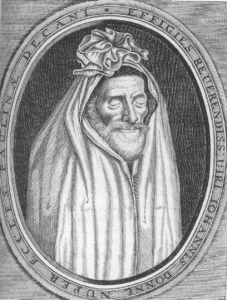Book Review, Katherine Rundell, Super-Infinite: The Transformations of John Donne, Farrar, Straus and Giroux, 2022

Katherine Rundell’s new book on the great English writer and cleric, John Donne is, among other things, a work of evangelism. Rundell says one of her goals is to get everyone to read some of Donne’s poetry. I could not agree more. Start with The Sun Rising, The Funeral, The Flea, or The Apparition, and dip into the exquisite prose of Donne’s Devotions Upon Emergent Occasions.
John Donne (1572-1631) was my first great love. My beloved mentor Thomas Clayton of the University of Minnesota English Department turned me on to Donne back in 1976. I wish I could say I never looked back, but I have allowed my life and career to waft and drift. At one time I was one of the world’s leading authorities on the sermons of John Donne. He was the most famous preacher of his era in London. He was dean of St. Paul’s Cathedral from 1621 until his death in 1631.
Donne was a contemporary of Shakespeare, Edmund Spenser, Christopher Marlowe, George Herbert, Ben Jonson, and Robert Herrick. You could spend the rest of your life reading the poetry of the 17th century and never exhaust its intense genius.
For more than a decade I studied Donne’s sermons with heroic obsessiveness. I read all 160 sermons again and again and made a list of Donne’s 641 references in the sermons to the work of the greatest of the Christian church fathers St. Augustine.
With a background like that I keep my eye out for new books on Donne. Katherine Rundell’s, published in 2022, has been lavishly praised. The test of a book largely devoted to explicating many of the 200 or so poems of Donne is whether the analysis illuminates those poems, explains the difficulties of those poems, opens those poems up, and sends you to your anthology to read those poems. I find Rundell’s explications spotty. It feels at times that she is more interested in being clever and provocative than in really helping the reader understand Donne. She sees him as a showman, a creator of verbal pyrotechnics, a master of intense effects; the same, I believe, could be said of her. It takes a lifetime of wrestling with the complexities of the 17th century to elucidate Donne.
Donne’s greatest critic is another mentor of mine, Oxford’s John Carey, who was Merton Professor of English until his retirement in 2002. His 1981 book, John Donne: Life, Mind, and Art, is the gold standard of Donne studies. Several critics have said Ms. Rundell’s book now takes its place next to Carey’s book. I disagree. Don’t get me wrong. I enjoyed her book, marked passages, took notes, and will read it again. But it has some of the weaknesses of the militantly informal postmodern time in which we live. It feels glib to me at times, and even a little vulgar.

Professor Carey’s fascination with the twists and quirks of Donne’s feverish imagination came as close to elucidating Donne’s genius as anyone since the English 18th century critic Samuel Johnson, who was annoyed by Donne. He famously said of Donne’s wild wit, “The most heterogeneous ideas are yoked by violence together; nature and art are ransacked for illustrations, comparisons, and allusions; their learning instructs, and their subtilty surprises; but the reader commonly thinks his improvement dearly bought, and, though he sometimes admires, is seldom pleased.” Donne wrote a seduction poem arguing that since his intended lover has permitted a flea to prick her and draw blood, why not the poet himself! The most famous (though not his best) of his metaphysical conceits (wild analogies, often based in science) compares a traveling male lover to a geometrical compass in which the “fixed foot” is the woman who stays at home; and though her lover travels, her stationary fixity ensures that he is drawn back home, as a compass is when it completes its circle. As usual Donne works in a sexual pun:
And though it in the center sit,
John Donne
Yet when the other far doth roam,
It leans and hearkens after it,
And grows erect, as that comes home.
I agree with Columbia professor James Shapiro’s review of Super-Infinity. “Rundell’s own style can dazzle, though at times the wit feels a bit strained, as when she describes Donne’s unreadable tract ‘Pseudo-Martyr’ as ‘so dense it would be swifter to eat it than to read it.’”

Rundell is a vivid writer, but I am not convinced that this book will stand the test of time. She often affects a racy, irreverent, deliberately provocative style, which, to use an English phrase, often seems “too clever by half.” On page 5, for example, she says Donne’s writing “if allowed under your skin can offer joy so violent it kicks the metal out of your knees, and sorrow large enough to eat you.” No good editor would have let this go unchallenged. On page 11, she argues that if we let Donne’s poetry slip out of our common literary memory, that “would be as foolish as discarding a kidney or a lung.” Really? What about the billions of people who have never had an encounter with John Donne? Nor probably would wish to. She seems to have felt that a book on the most intense, provocative, and witty of English poets must itself be intense, provocative, and witty.
England: Volatile History and Rich Language
Donne lived in one of the most volatile periods of English history, and certainly in the richest period of the English language. Like so many of his countrymen and women, Donne was born Roman Catholic, but after he had experienced the sometimes lethal hostility that the new Anglican establishment used against inflexible Catholics (called Recusants), he transferred his religious allegiance to the Anglican Church. Or did he? One of the questions that John Carey wrestles with better than anyone before or since is whether Donne was a sincere convert or merely an opportunistic one. Was he truly an Anglican for the bulk of his life or did he remain a crypto-Catholic. My view is that he genuinely believed that the Anglican “settlement” of the last decades of the 16th century and the first decades of the 17th was truer to the letter and the spirit of the Bible than the debased Catholicism of the late medieval period. Several members of his extended family refused to conform to the Anglican paradigm and paid for it with their lives. Donne’s own brother Henry died in a fetid prison after being incarcerated for sheltering a Jesuit in his lodgings.

When Donne was born in 1572, Queen Elizabeth I had been on the throne for 14 years. She was a decided Protestant, but she tried not to meddle in people’s religious faith as long as they worshipped quietly without calling undo attention to themselves. Elizabeth was the last of the Tudor dynasty. After her death in 1603, the Stuarts came to the throne for the next century. Donne preached under the reign of James I of Scotland, and Charles I, who would be beheaded 18 years after Donne’s death. Each of these three monarchs was a Protestant, but with quite different views of emphasis and tolerance. If there was a hint of opportunism in Donne’s conformity with the Anglican settlement, in that era when religion was the central fact of life, that is certainly understandable. You could lose your head then for espousing unacceptable religious views.
The Renaissance Obsession With Death
The Renaissance obsession with death is hard to fathom, and nobody of that era in England was as obsessed with death as John Donne. In the weeks before he died, he posed in his own funeral shroud and had his portrait painted as if dead. His final sermon “Death’s Duell,” preached on February 25, 1631, less than a month before his death, was so fixated on death and dying that those present agreed with his first biographer Isaac Walton that “he had preached his own funeral sermon.”
Here’s a little taste of the death trope in Donne:
And thy skin shall come to that absolute corruption. As that, though a hundred years after thou art buried one may find thy bones and say, this was a tall man, this was a strong man, yet we shall soon be past saying upon any relic of thy skin, this was a fair man; corruption seizes the skin, all outward beauty quickly. … When of the whole body there is neither eye nor ear nor any member left, where is the body? And what should an eye do there where there is nothing to be seen but loathsomeness? Or a nose there where there is nothing to be smelt but putrefaction? Or an ear where in the grave they do not praise God? Doth not that body that boasted but yesterday of that privilege above all creatures that it only could go upright, lie today so flat upon the earth as the body of a horse or of a dog?

Cheerful, huh? In our age of facelifts and tummy tucks, postponing death, denying death, pretending death is no factor in our lives, this sort of passage seems not just morbid but sick and maybe insane. But I could quote 500 passages of equal potency in Donne’s sermons. People flocked to them. Sometimes his parishioners in St. Paul’s murmured their admiration for 15 minutes after one of his great passages on “the littleness of man.”
I’ve thought about the Renaissance obsession with death for the last 30 years off and on. It had something to do with the fact that death was more omnipresent in Donne’s time than in ours. Our recent pandemic killed a little over 2% of humanity worldwide. The plagues (plural) of Donne’s era routinely killed one in 10, one in eight. Deformity and birth defects were a pervasive fact of life in the Renaissance. Hygiene was appalling. Human waste ran down gutters in the streets. Dead animals putrefied throughout London.
Death also seemed especially bitter in the Renaissance because — after nearly a thousand years of cultural darkness — the people of the time got a transfusion of optimism from the rediscovery of the classical world. The scientific revolution and the rise of rationalism, coupled with the shattering of the monolith of Christianity, made the world seem less like a vale of tears than a place where humans might possibly find a way to flourish. But death was as pervasive as ever and its omnipresence found its way to the new secular literature made available by the invention of the printing press. In other words, death seemed more appalling now that humanity had done some cheering up.
There was perhaps one final factor. The Reformation was answered by the Catholic Church by what is known as the Counter Reformation or the Catholic Reformation. One of the central positions of the Counter Reformation was that Renaissance humanism and neoclassicism were too cheerful, too optimistic about the human project. Artists and writers were instructed to focus on death, judgment, and human depravity. You can see this shift in its starkest formulation in the difference between the ceiling of the Sistine Chapel (completed 1612, about the time Shakespeare retired to Stratford) and the gigantic Last Judgment Michelangelo painted 25 years later. Death became a central leitmotiv of post-Renaissance art. Donne may have been absorbing and reflecting the change of focus of these years.
However we attempt to explain this, it is certain that you cannot spend much time with Donne’s secular poetry, his sacred poetry, or his letters and sermons, without a pretty full-on encounter with death and dissolution. As Rundell puts it, “Donne grew up knowing you were supposed to meet death with a flourish: he never forgot it, right to the end.” Somehow, I find all that refreshing, even when it is macabre and a little horrifying.
Super-Infinite is an excellent introduction to John Donne. It is a quick and lively read. Better yet, read John Carey. Better still, read Donne.
